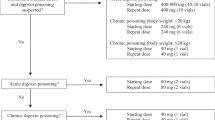Abstract
Objective
To evaluate the use of antidotal therapy in patients with an elevated digitalis concentration following chronic or acute exposure.
Design and setting
Retrospective review of patient records over 2 years in 20 city hospitals in France.
Patients
Overall 838 patients with an elevated serum digitalis concentration (digoxin > 1.95 ng/ml or digitoxin > 23 ng/ml) were included in the study. Of these, 67 (8%) had received antidotal therapy with Fab fragments.
Measurements and results
The relationships between previously reported prognostic criteria and use of antidotal therapy were investigated. We identified five independent factors that were associated with the use of antidotal therapy: acute overdose (OR 15.74), Fab fragment availability in the hospital (11.06), serum potassium (1.81), and heart rate (0.96). Mortality was significantly lower in Fab-treated (6%, 4/67) than untreated patients (15%, 117/770).
Conclusions
Antidotal therapy is underused in patients with an elevated digitalis concentration especially in patients with chronic digitalis exposure. These patients in our series presented a higher mortality rate than patients with acute poisoning. Although they were older and tended to have a history of cardiac disease, they did not differ from patients with acute poisoning with regard to the main severity criteria and prognostic factors. The use of identical criteria for antidotal treatment after acute and chronic poisoning should help optimize outcomes. Fab fragment availability is insufficient in France but ranks only second after type of poisoning (acute or chronic) in the multivariate association with Fab treatment.

Similar content being viewed by others
References
Smith TW, Haber E, Yeatman L, Butler VP Jr (1976) Reversal of advanced digoxin intoxication with Fab fragments of digoxin-specific antibodies. N Engl J Med 294:797–800
Digitalis Investigation Group (1997) The effect of digoxin on mortality and morbidity in patients with heart failure. N Engl J Med 336:525–533
Ordog GJ, Benaron S, Bhasin V (1987) Serum digoxin levels and mortality in 5100 patients. Ann Emerg Med 16:32–39
Borron SW, Bismuth C, Muszynski J (1997) Advances in the management of digoxin toxicity in the older patient. Drugs Aging 10:18–33
Hickey AR, Wenger TL, Carpenter VP, Tilson HH, Hlatky MA, Furberg CD, Kirkpatrick CH, Strauss HC, Smith TW (1991) Digoxin immune Fab therapy in the management of digitalis intoxication: safety and efficacy results of an observational surveillance study. J Am Coll Cardiol 17:590–598
Bismuth C, Motte G, Conso F, Chauvin M, Gaultier M (1977) Acute digoxin intoxication treated by intracardiac pace maker: experience in sixty-eight patients. Clin Toxicol 10:443–456
Taboulet P, Baud FJ, Bismuth C (1993) Clinical features and management of digitalis poisoning. Rationale for immunotherapy. J Toxicol Clin Toxicol 31:247–260
Taboulet P, Baud FJ, Bismuth C (1993) Acute digitalis intoxication. Is pacing still appropriate? J Toxicol Clin Toxicol 2:261–274
Smith TW, Butler VP Jr, Haber E, Fozzard H, Marcus FI, Bremner WF, Schulman IC, Phillips A (1982) Treatment of life-threatening digitalis intoxication with digoxin-specific Fab antibody fragments: experience in 26 cases. N Engl J Med 307:1357–1362
Smolarz A, Roesch E, Lenz E, Neubert H, Abshagen P (1985) Digoxin specific antibody (Fab) fragments in 34 cases of severe digitalis intoxication. Clin Toxicol 23:327–340
Wenger TL, Butler VP Jr, Haber E, Smith TW (1985) Treatment of 63 severely digitalis-toxic patients with digoxin-specific antibody fragments. J Am Coll Cardiol 5:118A–123A
Antman EM, Wenger TL, Butler VP, Haber E, Smith TW (1990) Treatment of 150 cases of life-threatening digitalis intoxication with digoxin-specific Fab antibody fragments. Final report of a multi center study. Circulation 81:1744–1752
Gaultier M, Welti JJ, Bismuth C, Motte G, Conso F, Chauvin M (1976) Intoxications digitaliques graves. Facteurs pronostiques. Intérêt et limites de l'entraînement électro-systolique: à propos de 133 cas. Ann Med Interne (Paris) 127:761–766
Dally S, Alperovitch A, Lagier G, Bismuth C, Fournier E (1981) Prognostic factors in acute digitalis poisoning. Nouv Presse Med 10:2257–2260
Lehmann HU, Witt E, Temmen L, Hochrein H (1978) Life-threatening digitalis intoxication with and without additional diuretic treatment. Dtsch Med Wochenschr 103:1566–1571
Bismuth C, Gaultier M, Conso F, Efthymiou ML (1973) Hyperkaliemia in acute digitalis poisoning. Prognostic significance and therapeutic implications. Clin Toxicol 6:153–162
Ellenhorn MJ (1997) Antiarrythmic drugs. Digitalis. In: Ellenhorn MJ (ed) Medical toxicology. Elsevier, New York, pp 541–549
Iapichino G, Morabito A, Mistraletti G, Ferla L, Radrizzani D, Reis Miranda D (2003) Determinants of post-intensive care mortality in high-level treated critically ill patients. Intensive Care Med 29:1751–1756
Lapostolle F, Alayrac L, Adnet F, Maistre JP, Leseur A, Lapandry C (2001) Disponibilité des antidotes dans l'aide médicale urgente. Presse Med 30:159–162
Petit P (1997) Antidotes, antagonistes et épuration des toxiques en préhospitalier. Septième Symposium de Réanimation Préhospitalière de Montluçon. Rev SAMU pp 61–67
Lapostolle F, Borron SW, Verdier C, Taboulet P, Adnet F, Clemessy JL, Bismuth C, Baud F (2008) Digoxin-specific Fab fragments as single first-line therapy in digitalis poisoning. Crit Care Med (in press)
Author information
Authors and Affiliations
Corresponding author
Rights and permissions
About this article
Cite this article
Lapostolle, F., Borron, S.W., Verdier, C. et al. Assessment of digoxin antibody use in patients with elevated serum digoxin following chronic or acute exposure. Intensive Care Med 34, 1448–1453 (2008). https://doi.org/10.1007/s00134-008-1092-x
Received:
Accepted:
Published:
Issue Date:
DOI: https://doi.org/10.1007/s00134-008-1092-x




